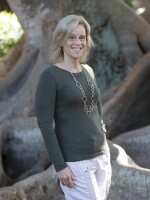Think like an engineer. That’s what students at Jamerson Elementary School in St. Petersburg have been hearing the past 13 years.
Now, Jamerson isn't the only school that applies science, technology, engineering and math into all of its classes.
But its approach of tapping into a child's natural problem solving skills did catch the attention of a recent technology education conference in Orlando. It named Jamerson the top elementary STEM program in the nation. In the school's classrooms and its fabrication lab, kids engineer their way through the school day.
One such lesson is a favorite among a team of five fourth graders. On a recent school day, the kids build a model rollercoaster to figure out how a car that plunges down a steep hill into a sharp turn doesn't go flying off the track.
A tiny silver marble is placed on top of a hill and the test run seems promising until the marble flies off the track and crashes into a nearby container of Lego's.
Student engineer Lucas Woodard is undeterred though. He said adjusting a section of the track could fix the problem.
“When it turns, it will be able to affect its speed," he said.
That ability to persevere through setbacks is a key principle at Jamerson, a place where state academic requirements are connected to engineering ideas on a daily basis.
Labor statistics predict there will be more than nine million Americans working in science, technology, engineering and math fields by 2022. That's made "STEM" a buzzword within education and among politicians nationwide.
Lukas Hefty, the school's program coordinator, said when Jamerson opened, it made sure to emphasize the "E” in STEM, and to do so starting in kindergarten. Here, he said a music lesson might include a session on instrument design and 3D printers are used for art projects.
"In our case we see STEM as more of an integrated curriculum that stretches across the school day, so our kids are learning science concepts, they're learning to measure and collect data in math, they're researching topics in language arts and they're putting all of that together into engineering design challenges," Hefty said.
Over in Debbie O’Hara’s fifth grade class, students are getting their STEM with a dash of social studies and economics. It's part of a five-week study on space that leads up to an overnight trip to the Kennedy Space Center. Today, O'Hara launches a debate about investing in the country’s space program.
The kids discuss the pros and cons when student Jose Rivera Vaughn jumps in with an opinion.
"I had a pro," he said. "It would be amazing to see new life forms that we've haven't seen before. Who wouldn't want to see that?"
The discussion evolves, and suddenly students are talking about the importance of education, and understanding math.
Demarria Raiford chimes in saying that as a Jamerson student, she’s kind of an expert already.
"I’m really good at multiplying fractions and decimals and adding and subtracting fractions," she said.
Her self-assurance is no accident. Hefty said STEM education is especially important for girls, a demographic well represented at Jamerson but not in the STEM workforce.
"What we've found is that our students go to middle school with more confidence, with more willingness to compete with the boys," he said. "So we're finding that they’re more successful than students coming from traditional schools."
Fifth grader Shaunt'e Shuler is a prime example.
"No, I'm not intimidated by boys," she said. "I feel like they should be intimidated by me."
Although today, fewer women study STEM in college than men - Shuler's teacher said the girls at Jamerson - and their generation -- will change that blueprint.







